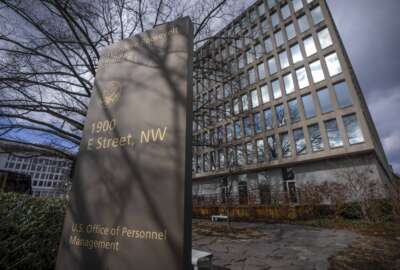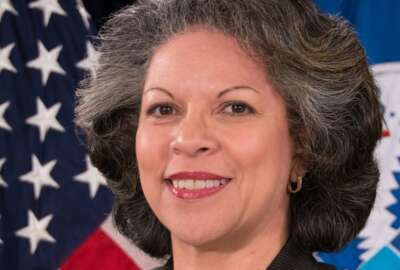This small federal office has a big task in the digital divide
"OMBI is a federally funded grant making office, All of the funding has already been distributed. And it went to 93 universities," Dominique Harrison said.
A small but persistent office in the National Telecommunications and Information Administration, part of the Commerce Department, has been working over the years to bridge one valley in the digital divide. The campuses of history black colleges and universities, as well as other tribal and minority serving institutions. We got an update from the acting director of the Office of Minority Broadband Initiatives, Dominique Harrison on the Federal Drive with Tom Temin.
Interview transcript:
Tom Temin Well, tell us basically what the [Office of Minority Broadband Initiatives (OMBI)] basically does.
Dominique Harrison Yeah. So that Office of Minority Broadband Initiative was codified through legislation of the Consolidated Appropriations Act in 2021. And we offer in partnership with HBCUs, which are historically black colleges and universities, hispanic serving institutions and tribal colleges and universities, the ability to partner on providing more access to broadband to those institutions, but also to their surrounding communities. One of the premises of our work is that anchor institutions, of which include higher institutions in libraries and other kind of important institutions, ironically, are so important in bringing resources and information to those who are in need. And so one of the ways that we see as being able to close the digital divide is to work with HBCUs, TCUs, HSIs and minority serving institutions to provide broadband. So under our office, we also foresee the Connecting Minority Communities Pilot Program, which is a program that gave funding to these institutions, HBCUs and minority serving institutions, as a way to close the digital divide. One of the things that people have used their funding for is to provide access to Internet on their campus and their surrounding community, and to make upgrades to their infrastructure. That means having more bandwidth and capacity to do different kinds of things online. The second is that funding has been used to buy devices and even hotspots so that students and community members are able to access the Internet. And lastly, folks have used this funding to develop training and courses around digital literacy, telehealth and such. That helps folks who want to be online being able to use the Internet in ways that are useful to their lives. So that’s just a little bit about the office.
Tom Temin And I imagine the situations vary. For example, a well-known college like Morehouse is in the Atlanta area where you have a very rich infrastructure, generally. So the challenge there might be different than any institution, HBCU or otherwise, that’s in a rural area where nobody has great broadband. Fair to say?
Dominique Harrison Absolutely. We’ve had conversations with grantees and universities that are in rural environments. And yes, the challenges and the need are different, but there are a lot of similarities to those who are in urban areas with much larger populations. Particularly, smaller universities with smaller headcount of students, may not have the funding or the resources to advance their broadband infrastructure or provide devices to their students. And so those are the type of grantees that we’ve been able to support and see some of the incredible work that they’ve carried out through their projects. I want to mention that our colleagues on the digital equity team at NTIA have started to give out billions of dollars as it relates to closing the digital divide. And they’re working across eight covered populations, in terms of being able to provide broadband. And some of those populations include our grantees, including rural communities. I just want to just mention in my prior work, I did some research on African-Americans in the rural South. And what’s very intriguing about that area is that there’s been a lot of loss with companies that move out of the South or work that has been transferred overseas. You have low education rates, you have high unemployment, you have a number of hospitals that have left the area. And so all of this creates the situation context for the need for broadband infrastructure so that folks who are and who remain in those communities have access to these types of resources and information.
Tom Temin We were speaking with Dominique Harrison. She’s acting director of the Office of Minority Broadband Initiatives, part of the National Telecommunications and Information Administration. And even in an area, as you point out, that might be rich in broadband and fiber, etc., within a campus of, say, a minority serving institution that may not have, let’s use the example of medical school. Well, medical medicine is going tele, and remote surgery and robotics and artificial intelligence. And so for a given course, the nearby big rich college, which can afford all of those devices and remote robotics and so forth, even though they both have equal broadband, the other school may not have the resources to take advantage of it, is what you’re saying?
Dominique Harrison Yes, absolutely. And that’s just the great thing about all of the amazing work that’s being done by the grantee. With modest funding, they’ve been able to have such an impact on their students and community members. As I mentioned, you brought up Morehouse School of Medicine, and they have a great telehealth digital equity project in which their students are using funding to buy iPads, but also to get training and being able to have the kind of latest skilling in what would you say using technology in medicine. But they’re also being able to collect, connect with community members and at clinics around the Atlanta area to provide telehealth services. As many of folks know, during COVID, during the pandemic, a lot of folks realize it just emphasize the digital divide. And so many people had to turn online for services such as giving information about COVID, and signing up for those tests. And HBCUs, along with other minority serving institutions, played an important part in being able to provide that kind of information to help people sign up for shots and get the treatment that they need. And so it’s just remarkable how folks are able to tailor their project to the specific kind of challenges and opportunities in which the communities that they serve.
Tom Temin And is the Office of Minority Broadband Initiatives, are you primarily a grantmaking organization? And give us a sense of the volume of grant applications that come in. What kind of funding are you able to offer in a given year?
Dominique Harrison Yes, absolutely. So OMBI is a federally funded grant making office, All of the funding has already been distributed. And it went to 93 universities, including HBCUs, HSIs, tribal colleges and universities and minority serving institutions. And by the way, when I say these different types of universities, I’m saying it because their unique definition to all four of those categories. And so we gave about 268 million to those 93 universities. You can find more information about those specific projects on our OMBI website under ntia.gov. But the amount of applications that we actually received exceeded over 800 million in funding requested, and over 200 applications. So it just emphasizes that there is still so much work to be done. But given the funding that we have, I think we’ve done a great job in really living out the mission and vision of what this organization was developed for. I also want to say that our colleagues on our B-team, that’s broadband equity access appointment program, as well as the digital equity program, have billion dollars, many, many billions of dollars of funding that they’re providing right now to states and specific kind of stakeholders to provide access to the Internet, but also to build the infrastructure. So we are all working in tandem to address these challenges in different ways.
Tom Temin Well, maybe they should have a different name than the B-team, when they have that much funding. But will your office get more funding for another round once Congress gets around the appropriations for 2025?
Dominique Harrison Well, that is the desire. We’re hoping to continue this work. For the future, what we’re hoping to do is to continue to provide technical assistance to our grantees, and supporting them through the duration of their projects to make sure that they are successful, but also to provide resources, information that helps to sustain those partnerships and the projects that they’re doing. The great thing is that our DE colleagues continue to have funding that will roll out and also have a competitive program right now where applications are due soon. And so we’re trying to ensure that we’re connecting those applicants who are working with the DE team to our grantees so they can really have an enormous impact by working together in partnership.
Tom Temin And by the way, how did you come to this work?
Dominique Harrison Great question. So I actually did my dissertation at Howard University, an HBCU. And I focused on making sure that telecomunications policy benefited women and girls in Jamaica. My family is actually from Jamaica, and I realize the disparity as it relates to broadband there, but also just worldwide. And so the importance of kind of my background in this area is that you need a variety of stakeholders to come together to develop policy, both industry, government and nonprofit, because they all bring their varying expertise to the table, and can really advocate for issues on their organization’s behalf or communities. And so what I found, through the dissertation, that nonprofit organizations play an essential role just because of how close they are to specific kinds of community members. And we can see that in the work today at OMBI.
Dominique Harrison I’ve been here for a little over five months, but it really is rewarding to have written about these issues in earlier days, advocated for these issues in my nonprofit and think tank prior roles, and now be a part of the change in government to see how we can all work together to close the digital divide. But I would be remiss if I didn’t mention Dr. Francine Alkisswani, who is really a hidden figure to me. She has been in our program at NTIA for over 20 or so years, and she played a really essential role in standing up this work. She had a detail at the Department of Education where folks were talking about how do we as federal agencies help to support HBCUs. And she was advancing the topic of broadband and Internet and how that was important. And so through that work, she continued to advocate on that issue. She got, after her detail at the White House, she came back to NTIA and helped to work with a number of folks around the agency to get this into legislation. And so she is a real important pillar of this program. And I just think she deserves all of the applause and praises in the world.
Tom Temin Yes. And she is the most recent Paul Volcker Award recipient for public service over a lifetime. And I had the chance to meet her at the recent SAMMIES ceremony. So terrific that you mention her. Dr. Dominique Harrison is acting director of the Office of Minority Broadband Initiatives at the National Telecommunications and Information Administration. Thank thanks so much for joining me.
Copyright © 2024 Federal News Network. All rights reserved. This website is not intended for users located within the European Economic Area.
Tom Temin is host of the Federal Drive and has been providing insight on federal technology and management issues for more than 30 years.
Follow @tteminWFED






